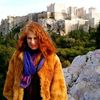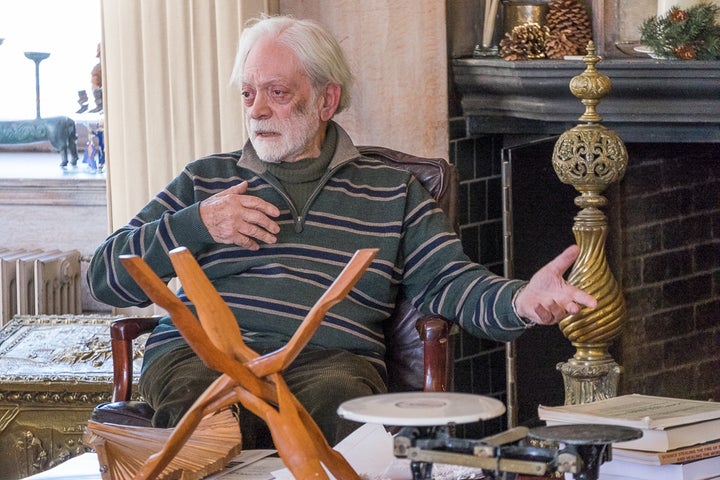
Albert Levis, M.D., also known as the Wizard, presenting his ideas to fellow Vermonters.
Dr. Albert Levis is a Renaissance Man who has invented a holistic science to meet the challenges of the highly conflicted era crystalized by the Trump presidency. A Holocaust survivor born in Athens and trained as a psychiatrist in Zurich, Levis’ life-long pursuit of an integral, holistic healing modality has culminated in the validation of his Formal Theory into the Science of Conflict Resolution, the Moral Science.
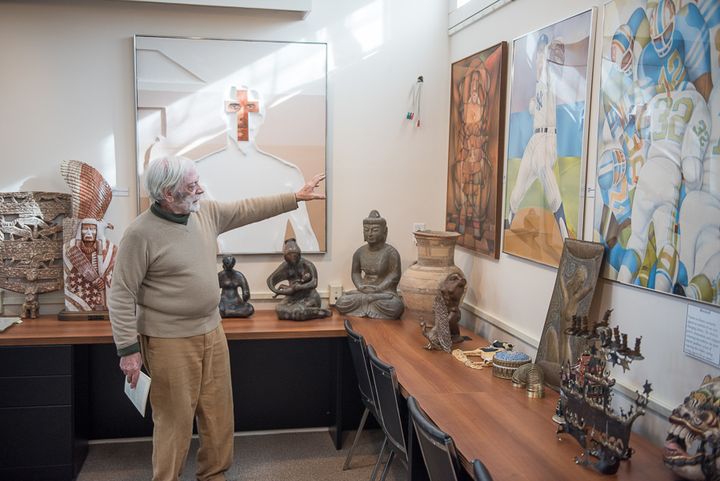
Albert Levis, articulating his theory in Museum of the Creative Process that he founded on his Vermont property.
Also known as the Wizard of Manchester, Levis’ self-sufficient and self-contained method of personality assessment and internal conflict resolution is available to the masses through the software wizardry of his son Dr. Max Levis, who holds a doctorate in psychology. Stunning in its simplicity and the beauty of its harmonic design, the Formal Theory puts into play the Moral Science marrying natural science with psychology, philosophy and religion. This is a tremendous claim, yet gauging objective success can only be achieved through subjective experience, and this is perhaps the greatest triumph of the system: it applies the classical adage “physician heal thyself” to cut through the doctor/patient dichotomy that Deleuze and Guattari sought to heal through literary deconstruction (Anti-Oedipus: Capitalism and Schizophrenia).
I entered into Levis’ system by taking his Conflict Analysis Battery (CAB) available online. In cyberspace, I instantly became aware that not only is the delivery method in keeping with the technological era; the system reflects an evolution into Web 3.0: fully self-contained, self-regulating and self-generated through the marriage of creation and self-analysis within a feedback loop. This experience of becoming both participant and audience to a mass paradigm leap makes users as self-sufficient as the system itself. In short, the Formal System, which focuses on power management through conflict resolution, is precisely what America has ordered by electing Donald Trump into the Oval Office.
Thus, the marriage of artist/audience and internal/external proactively pursued for 20 years as a critic climaxed with the self-healing process of the CAB. And yet there was more to come. My personal alchemical process of transformation culminated in an online interview with Dr. Levis over the course of a week in March 2017. The big surprise comes at the end: a startlingly innovative wellness diagnosis of Trump complete with a prescription for self-healing of America’s leader and the nation itself.
ORIGINS

Albert Levis, M.D. and his son Dr. Max Levis in a pensive moment during a workshop at the Museum of Creative Process.
LS: Your Greek ancestry seems to be the key to the global application of your system as it is based on classical myth. Did you study the classics on your way to becoming a medical doctor, or are the classical myths of human origin ingrained in every Greek schoolboy?
AL: I watched the movie Electra that made me think of family relations. It was about Agamemnon’s Trojan war against Helen of Troy, a runaway wife, which ended with his being murdered by his own wife Clytemnestra, Helen’s sister, and his daughter and son killing their promiscuous mother. This led me to observe relations in the Greek cosmogony as a pattern of family relations repeated five times. That was my breakthrough because in this periodic phenomenon I encountered the recurrence of a pattern, murderous interactions between fathers and sons, repeating itself five times until the arising of a resolution. The solution to a child resolving his conflicts with an almost murderous mother was the beginning of a religion; thus, the son Erichthonius built a temple, the Parthenon, to his virgin mother, Athena.
LS: You are a Jew born in Greece. Did this outsider status contribute to your understanding of the pattern that created the classical Greek religion?
AL: The Greek father-son relationship was antagonistic, contrary to the Judaic father-son covenant, which was cooperative. In the periodicity of the repetitions of the pattern completed with a cult, I saw the energetic exchanges of the pendulum oscillation leading to the transformation of chaos to order. In the cultural alternatives between Judaism and the Greek culture , I saw cooperation versus antagonism, formal operations at work. In Piaget I learned more about formal operations as the three formal operations balancing the trays of a scale.
LS: Can you relate an incident in your education that determined your future direction as the inventor of a new scientific method?
AL: A psychoanalyst screening my competence as a candidate for psychoanalytic training questioned my relationship with my father. No, I did not hate my father, I told him. He sensed I was fighting the Freudian paradigm and rejected me as a candidate for analysis.
LS: Is this the origin of your declining the customary diagnosis of illness in favor of wellness?
AL: I am Freudian at heart in the sense of thinking psychodynamically. Yet, my psychodynamic model is purely relational free from the Oedipal sexual focus. Power remains the key concept and my therapeutic modality is called “power management”. The current diagnostic manual is totally medialized; conflict and power analysis is replaced by lists of symptoms.
LS: How did you evolve to incorporate all these other concerns divided into the separate and unrelated fields of psychology, philosophy and religion?
AL: I have been working systematically for years and finally the work is completed. My quest for meaning that started with my childhood experiences of the holocaust and the devastation of Europe is concluded with an educational program that understands psychology and religion founded on the scientific study of the creative process.
LS: How did the personal experiences affect the character of your childhood in Athens?
AL: It was a strong internal conflict for a kid born in 1937 to emerge from persecution, hiding, losses and bombardments to view the temple of Athena on the way to school every day.
LS: Is this how the classics and conflict were externalised in your environment – physically?
AL: A theatrical experiment creatively guided me right into the crux of conflict as the core of family relations. I wrote a play, “The Argives”, it could have been called “The Arians” about the genocide of the Trojans as equivalent to the Holocaust and discovered the secret of the creative tension in this – and other classical theater – was in the gender relations of the Greek family. In my scientific investigations, I began to understand how these relations evolved through the resolution of conflict. Greece evolved from very cruel Matriarchy to a less cruel Patriarchy. India discovered cooperation in Asceticism and Judea mutual respect in Monotheism. Religions discovered science.
LS: Was this exercise also the origin of your understanding the role of creativity in the science of psychology?
AL: Yes, as I began to research Greek literature and theater, I discovered that epics and scriptures were merely stories of conflict resolution in family relations and that they were measurable along the three formal operations, the equilibrial principles of the trays of a scale. My scientific method led me to I shift my focus from the narrative to the plot, where I identified the creative process as the scientific moral paradigm; the key was in the plot as a scientific conflict resolution phenomenon. In the scientific analysis of process I found the definition of the human unconscious.
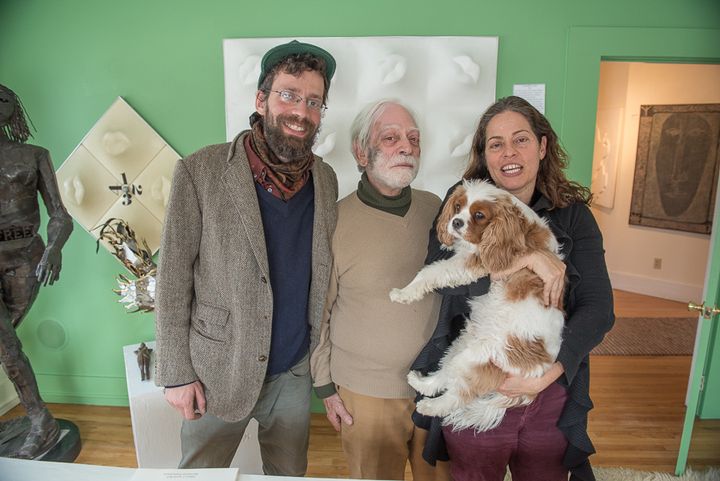
Albert Levis with his son, Max Levis, and daughter, Melissa in the Museum of Creative Process founded by Dr. Levis.
LS: Your system is about the transformation of conflict and personal command of power that psychoanalysis — and just about every school of psychology — originates with family. You have certainly set a positive model through your family enterprise. Your son Max has a Ph.D. and collaborates with your writing and software as well as web development and your daughter runs the family Inn, along with the Museum of the Creative Process. How did this evolve?
AL: I was a very lucky man in marrying a loving wife who was dedicated to having a big family and supportive of my Quixotic enterprises, like buying an Inn in Vermont , while I still had a practice in Connecticut. We put a great deal of creativity into the kids’ non-religious Bat Mitzvahs. Now our children complement each other with different but interconnected interests in our beautiful Manchester, VT community.
MORAL SCIENCE
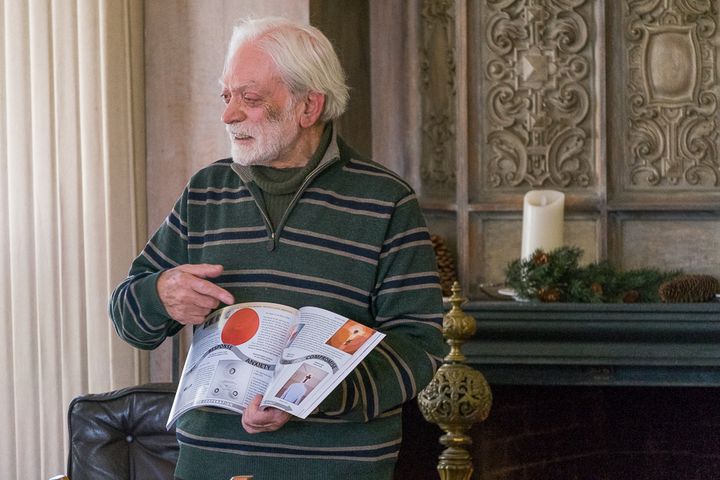
Albert Levis, M.D. explaining his invention of The Moral Science through the diagrams in his book.
LS: Moral Science seems to be a contraction in terms. Explain what this new science is and its potential for shifting the paradigm that is holding America hostage to dogma and agnosticism.
AL: The essence of the new science is in its relational methodology: the nature of the creative process is newly examined as a circumscribed scientific entity whose parts are formally interrelated completing a moral task, conflict resolution. Science is in detecting the formal and energetic structure of the unconscious thought process. The pattern evolves predictably transforming reciprocal, opposite and correlative states within a circumscribed entity. The unconscious binds science with moral evolution.
LS: So, a passive or negative response, is still considered a crucial dynamic in the relational matrix?
AL: This means that passivities and activities dynamically interrelate as reciprocal, while cooperation and antagonism as opposites, while alienation is resolved into mutual respect. This is the function of the unconscious; it is a self-driving car and we better find out where it is taking us.
LS: What does this mean in regards to the existing medical model?
AL: The medical model for diagnosis is non- relational, non systemic; it is not holistic.
LS: You couldn’t find this complimentarity existing in the psychological models you were familiar with?
AL: The medical community views “holistic” as psychosomatic, not in the scientific method detecting a moral outcome. There is no recognition of the thought process as a circumscribed entity that is a conserved energetic quantity yet transformed deterministically to the upgrading of order, moral closure. Moral Science understands the closure as conflict resolution.
LS: Psychology is defined as the science or study of the mind. It seems that you are addressing the shadow: the mind which psychological practice uses to understand human thought processes.
AL: The concept of shadow is a metaphor, which I am not clear what it refers to. Psychology missed out in studying the construction of the thought process, along with its moral or conflict resolution function. Aristotle identified the dramatic process connected as hubris and deke; this is what I call science. As a philosopher, he identified justice corresponding to science. I clarified the science by introducing into philosophy the physics and math of the unconscious process. I stole the moral authority ascribed to the divine and ascribed it to the unconscious. That is what Prometheus did metaphorically as he stole the fire of the gods and gave it to the mortals.
LS: In honouring the unconscious as a healing method, the Formal Theory resolves a problem that has been haunting western philosophy since the exile of C.G. Jung. Jung developed a system of interpreting the collective unconscious through dreamwork and the revival of alchemy – with its occult systems of numerology and astrology. Freud related all conflict to the libido and never acknowledged a universal unconscious dismissed as “the occult tide”. What do you think Freudians would make of your system?
AL: Jung explained things relationally. For example, his well-known model of distinguishing introverts and extroverts is now used in the Myers-Briggs assessment. Yet, like his mentor Freud who obsessed with Oedipus, Jung got carried away with arbitrary interpretation of myths. I get lost in hi speculations.
LS: How then did you utilise Freud’s psychoanalytic structure – the id, ego and superego – as a foundation for your breakthrough?
AL: Freud introduced seven models or assumptions in developing a new psychology. My work completes all his assumptions. My methodological innovation redefines the unconscious by means of interpreting defenses as the formal operations, by interpreting the fragmented unconscious as: id, ego and super ego as the continuum of the scientific six-role process, interpreting transference by identifying the four relational modality diagnoses. I have altered his technique of free associations on the couch to standardising completing a set of exercises for creativity to reconstruct the emotional dialectic, as the means for self-discovery and emotional catharsis. I have translated his concept of “sexuality” into one of the symbolisms of normative power management. Libido and Thanatos are translated into cooperation and antagonism.
So considering all these transformations of classical Freudian theory, I think Freudians would welcome the Moral Science as the vindication of Freud. The Formal Theory addressed a crucial fact that escaped Freud. He went too far with axiomatic speculations on a number of levels such as the concepts of sex and Oedipus. This obsession caused him to ignore the difference in methodology between axiomatic versus the relational method.
LS: Can you explain the axiomatic versus relational method and why this is essential to the Moral Science?
AL: I can explain it like this: Freud introduced axiomatically the Oedipus complex as a universal phenomenon. Accordingly, Joseph Campbell identified all cultural heroes as Oedipus with a thousand faces. I introduced the alternative: the Greek creation story as a periodic phenomenon, a pattern that repeated five times — one for every generation. A pattern is relational thinking. Periodicity is science; I adopted the formulas of two scientific phenomena. The formulas of the process can be true for any value of the relational variables. The four modalities are syndromes of the alternative ways of relating as the set of interrelated emotions and behaviours.
LS: Science needs data, i.e. measurement. How can we measure patterns?
AL: There are two aspects in patterns: the three relational principles of conflict resolution, and the six-role process of the three pendulum oscillations. The formulas of balance and the formulas of energy of the pendulum oscillation explain the personal variations.
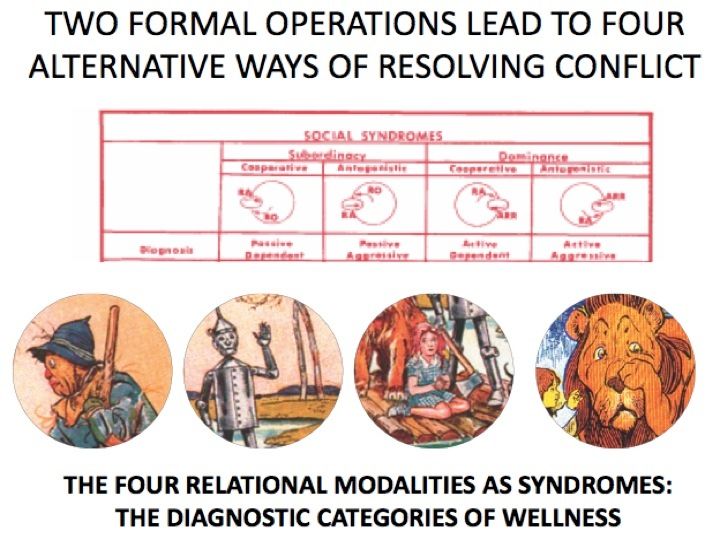
LS: It has recently been divulged that Jung and Wolfgang Pauli, the father of 20th century physics, were engaged in a 30-year collaboration to marry psychology and science. This is also the objective of your system. What are the benefits in bringing science and psychology back together?
AL: The delicate connection was identifying science in the thought process. Unlike mechanical systems, the psyche upgrades energy. You can think of the psyche as chlorophyll and photosynthesis. The process was identified in Genesis. The unconscious predictably transforms chaos to order in six steps. The six days of creation are the greatest metaphor for the unconscious creative process. And the process is the scientific definition of the Creator, the human divine and what we call the unconscious.
LS: This example is surprising because it connects the process of the psyche to biology and morality. Wouldn’t that make it material, as opposed to spiritual? Does science need to consider the psyche material in order to measure it?
AL: Psychology missed out on observing the unconscious as a transformational pump, a biological homeostatic mechanism, leading materialism to attitudinal change and spiritual growth.
LS: Can you relate your influences from both fields, science and psychology, to arrive at this powerful image?
AL: The two explain the thought process predictably unfolding to spiritual and cultural growth in all stories. Psychology reflects the human need for reduction of psychic tension and social deviance. Science comes to identity conflict as social deviance, as the mechanical shift of a person as a pendulum’s displacement within the field of normative gravity. This normative deviation is experienced as psychic energy, we feel it as emotions. The associations evolve along pendulum oscillations and usually stop upon the third oscillation. Why? Because conflict energy is transformed into art, thereby reconciling two items in opposition. Art is bound energy.
LS: From your holistic perspective, why do you think it was such a struggle to bring these separate fields of science, art and science together?
AL: Einstein identified matter as energy. I identified emotions as energy reconciled and processed. Energy is science. Freud was right in seeing cathexes as energetic ideas and catharsis as energetic release. Yet, his mistake was he deviated from science and became philosophical about all this. He missed seeing that ideas are relations and that both are measurable parameters of energetic entities.
LS: That is ironic, considering Freud was a neurologist, and intent on remaining a man of science all through his penetration into the psyche. Why do you think he failed to understand the possibility of energetic transformation?
LS: From your holistic perspective, why do you think it was such a struggle to bring these separate fields of science, art and science together?
AL: Einstein identified matter as energy. I identified emotions as energy reconciled and processed. Energy is science. Freud was right in seeing cathexes as energetic ideas and catharsis as energetic release. Yet, his mistake was he deviated from science and became philosophical about all this. He missed seeing that ideas are relations and that both are measurable parameters of energetic entities.
LS: That is ironic, considering Freud was a neurologist, and intent on remaining a man of science all through his penetration into the psyche. Why do you think he failed to understand the possibility of energetic transformation?
AL: He did very well in explaining the existence of energy in ideas. He just began on the wrong conceptual method. He made many good assumptions but did not correlate conflict and resolution as a conserved physical entity, a quantum of conserved energy. He failed to associate a system of ideas in the thought process with an energetic transformation that literally upgrades energy and brings the emotional pendulum to stop its oscillation. He failed in recognising the obvious that plays end upon the third act.
LS: That would seem to be the task left to his students, such as Wilhelm Reich. My father was in the wave of sixties Neo-Reichians. I grew up with the understanding of emotion as e-motion=energy in motion so repression of emotion was the same as repressing one’s energy, and the capacity to do work. Were you influenced at all by the Reich’s Orgone and the sixties sexual revolution?
AL: Energy is a reality, but we have to see it metaphorically as thinking outside the concrete box. I talk about energy in terms of normative deviation experienced as an internal emotion, a force opposite to the external deviation. The six role process is completed with returning to the rest state. Reichians and bioenergetics focus of release of energy. Energy release is a type of very therapy that is good for submissive people but not for dominant ones, who have a problem restraining their power. I see therapy as optimising energy or power management.
CONFLICT ANALYSIS BATTERY (CAB)
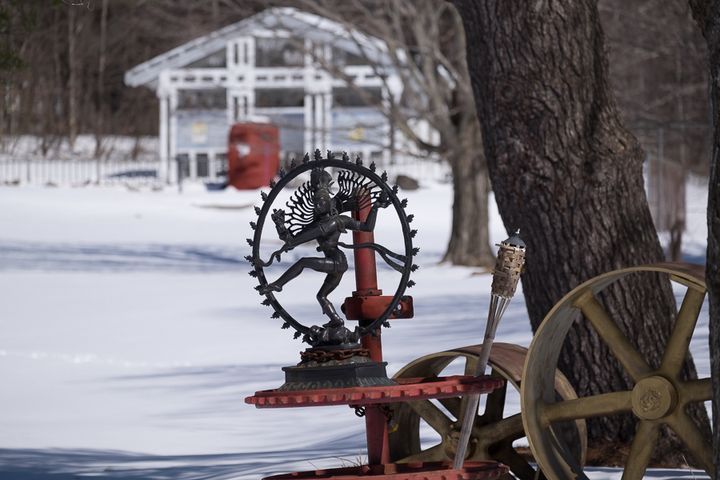
A Shiva lords over the Levis property in Vermont.
LS: There is also the duality at work within the Formal System that I experienced in taking the Conflict Analysis Battery (CAB), which involved making 12 freeform sketches in one sitting. I am referring to the duality of inner and outer. What are the real variables at work in your system establishing this balance?
AL: There are two phenomena of science that the assessment measures. The first is the mental steering as a personality type along the two dichotomies: dominance/subordinancy, cooperation/antagonism. The personality inventory identified you as dominant cooperative: a 4.5 score out of 6. All other modalities were lower than 2. The second is the mental energy driving your thought process unfolding in six steps illustrated by the ten individual tests; each of these tests corresponds to one of the emotions. They show your dominance evolving from the stress exemplified with your innocent childhood cultural preference for a six- pointed star for the Christmas tree, completed by a compromise, your short story of an uppity flier getting grounded by surrendering to a loving partner. The inventory is validated by the pattern manifested in each story but also all stories integrated into your personal drama.
LS: I really benefited from your battery as it encapsulated the resolution of my childhood conflict by way of relaying the origin of my art critical theory of the hieros gamos. Your modalities are right in keeping the international avant-garde in utilising the sacred marriage of both halves of the brain to create a Self-generated narrative of interwoven words and images from the unconscious. Synchronistically, this dynamic is taking place right in this interview! My personal breakthrough regarding the duality of number as both quantity/quality makes me intrigued by your use of number as variables.
AL: The relational score quantifies the alternative relational modalities. Your score gives you your wellness relational diagnosis. Kabbalah is about mystical numbers. Your hieros gamos concept is marrying opposites spiritually with the reference of climactic energy integrating physicality and spirituality. My perspective focuses on the physical processing of ideas. You are experiencing its spiritual and libidinal dimensions — translate your emotional experience into physics and loose your poetry. My variables are the formal operations as two formulas: Inverse = the product of reciprocity, negation and correlation. The six-role processes are the three pendulum oscillations. Everything else like numerology is spirituality and poetry.
LS: I have experimented with alchemical processes on the psyche for over 30 years and your testing seems to be the epitome of this journey, resulting in some key dreams indicating significant external change. I never knew I could draw so much meaning so fast. but I also knew that if I didn’t let the unconscious guide my creative output, I would never have been able to complete the self-assessment. How was this method of relying on the unconscious for a very high creative output derived?
AL: It is art therapy with a standardised approach of generating a conflict and its resolution and engaging the creator to analyse it as a pattern that may be optimised. The assessment combines measurements along the two mechanisms: the operations of the equilibrial scale identify the relational modality and the pendulum oscillations, identified by the projective tests. The inventory of the battery identifies one’s formal operations as one’s relational spectrum, quantified with numbers pertaining to the four types of resolving conflict, the four personality types. The creativity exercises identify the six emotions. The exercises placed in a sequential narrative reconstruct the six-role process. There is correspondence between the two methods. The inventory captures the unconscious resolving conflict with numbers. The images capture its unfolding with emotional experiences organised dynamically along the formally interrelated states of the process.
LS: Yes, and I feel I greatly benefited as a writer for seeing this personal narrative mapped as process through interrelating words and images in the Conflict Assessment Battery. In fact, my memoir opened with my memory of being chastised for putting the Seal of Solomon on top of the class Christmas Tree; this prompts me to go back and view how the three memories elicited in your text forming the six-role narrative of conflict resolution – clearly identified in my case through the symbol – led me to the establishment of a critical art theory around the pentagram and Seal of Solomon.
AL: In the three conflictual memories you manifested the early relational modality of being dominant. It helps the test taker to recognise the significance of one’s relational diagnosis. It is also manifested in your identity with the lion image in several tests. You are a powerful lady and that is your way of relating since you were a child. The insights might help you restrain your power; dominance can be problematic.
WELLNESS DIAGNOSES
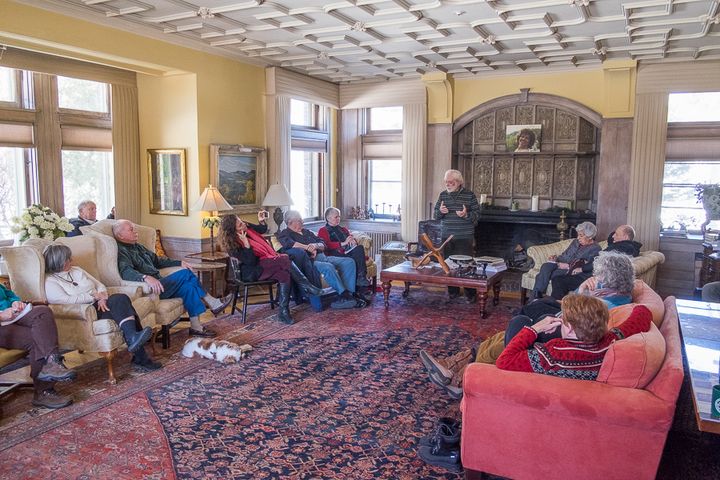
Albert Levis, M.D. giving a talk in the family run Vermont Inn.
LS: The system you established confronts head on what may be the biggest problem in American medicine today – the reductionism of science that breaks a diagnosis into its most minute parts and refuses to even look at the whole person, never mind see it as an integrated entity. Your writings pinpoint the current medical condition as a “paradigm of sickness” in which medicine treats disease as symptoms rather than as relations and wellness. Explain how this idea of wellness evolved into your system.
AL: Psychology became medialized as a reaction to the ineffectiveness of psychoanalysis. I rediscovered psychodynamic thinking, but grounded it on science. There is a lack of wellness psychology, yet all people are in need of understanding the nature of their personality’s features, its strengths and its liabilities. There-in is therapeutic information for everybody.
LS: You mean the nature of relations apart from Freud’s obsession with sexual relations?
AL: Relations are about managing power. Sex is only a symbolism of power as it pertains to moving in a field of highly energised power roles states. Freud’s conceptual mistake was his focus on repressed sexuality. In our times we have less problem with repressing sexual thoughts and behaviours. The essence of conflict now is the formal interrelationship between power and attitude as normative deviations.
LS: How does your wellness diagnosis work on a patient?
AL: The diagnostic categories identify patterns, as syndromal and relational ways of relating or managing power. They are predictive, meaning they explain emotions as well as behaviours. Patterns reflect personal power management. A good analogy for an individual becoming conscious of a personal pattern is like suddenly becoming aware of riding a self-driven car taking one to places that create trouble. While the consciousness of one’s patterns is an education, its resolution lies in the knowledge that one can enter the driver’s seat and go where you consciously want to be. Once you become conscious, you can drive your car better. That is power management. The overall effect is the reduction of conflicts or symptoms. Dominant people abuse power and experience anxiety. Submissive people underuse power and experience hostility or depression. To treat anxiety and hostility symptoms one has to modify one’s power behaviours.
FORMAL SYSTEM
LS: FORMAL SYSTEM is a general term gives your method an air of…well…formality, in addition to conclusiveness. How did you come up with this term?
AL: Methodology was the first concern in developing the Formal Theory. I was seeking explanation of the process and that is when the method of linking parts strictly within the context of totalities led me to identify the difference between arbitrary propositional and non-arbitrary relational methods.
LS: You present the conflict resolution process in six roles or stages that unfold as a three-act play. Explain how this process works – how you get from the six to the three corresponding to how drama is structured.
AL: Analysing the transmission of the pattern from generation to generation, I identified the six- role process: Stress, Response, Anxiety, Defence, Reversal and Compromise. Three roles states connected the individual to the father, the earlier generation; the other three connected the individual to his or her own children, the next generation. In this way, you cover the parent-child and child-parent relation within any society as any particular approach to resolution.
LS: Your methodology certainly reveals why The Wizard of OZ is one of the most beloved tales in America. The 1939 American musical comedy-drama fantasy film viewed entering my home via TV was an event for the sixties generation. How did you conceive of using the characters of The Wizard of Oz for your typologies?
AL: My son Max brought The Wizard of Oz story to my attention. I saw the four main characters as describing the four relational modalities determined by two dichotomies of conflict resolution: passivity versus activity, and cooperation versus antagonism. Dorothy is dominant cooperative, the Lion is dominant antagonistic, the Scarecrow is submissive cooperative, and the Tin Man is submissive antagonistic. Now the testing is called the Wizard as a nick name.
MUSEUM OF THE CREATIVE PROCESS
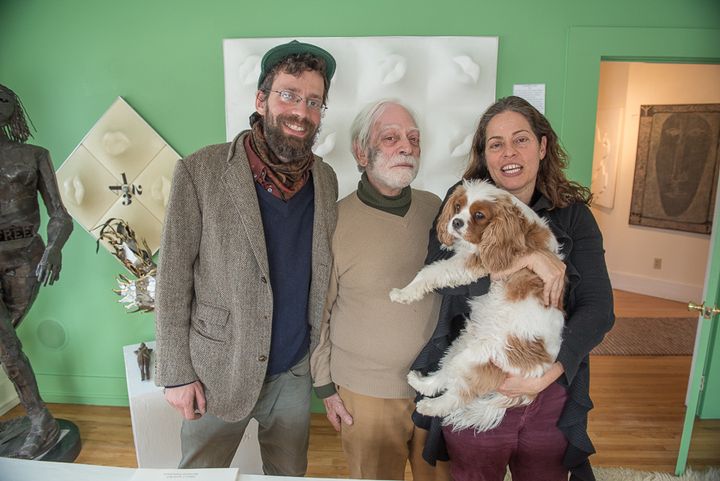
Albert Levis, M.D. and his son Dr. Max Levis and daughter Melissa in the Museum of the Creative Process founded by Dr. Levis.
LS: You are a rare scientific inventor who has created a museum to exhibit your ideas. How did you come to establish the Museum of Creative Process?
AL: I started collecting Gorski paintings upon lecturing on the formal operations to a group of physicians. Then, as an educator I had to get more art as the means of explaining the universal harmonic.
LS: Explain how the museum is structured. Are there changing exhibitions along with a permanent exhibition?
AL: There are five permanent exhibits. All of these assist in demonstrating the process as a universal harmonic consistently unfolding in art, religion, stories all outlets of personal expression.
LS: What artists do you collect?
AL: The permanent Gorski Retrospective introduces the viewing of art as reflecting the artist’s lifetime of conflicts. The canvases capture the six role process as dramatic continua. I have identified several periods and conflicts making his paintings meaningful and also illustrating the process. Each period ends with a moral discovery, usually a crucifixion. The sculptural trail consists of many artists contributions that I have used to illustrate cultural continuity in discovering science by improving family relations.

Alfred Levis with just two of his extensive Gorski collection in his Museum of the Creative Process.
LS: Elaborate on the museum’s educational programs.
AL: The program, I call it: Creativity and Power Management is a concise emotional education that serves a three-fold mission: the first consists in viewing the art exhibits to learn about the creative process as a scientific phenomenon. The second objective is using creativity for self-discovery by completing the self-assessment that you took online, which generates a report upon completion of the testing. The third objective is examining cultural stories to identify the alternative religions as discoveries of the science of conflict resolution by playing as a group, Moral Monopoly. The game retraces the history of religions progressing restructuring the family roles improving family relations. Players discuss how the Moral Science completes the evolution of religions with a paradigm shift. A fourth segment of the program is establishing a diagnosis for president Trump and for the three Abrahamic religions as differing in valuing alternative relational modalities.
LS: What is Moral Monopoly?
AL: The game utilises the formality of the playing deck of cards to illustrate the differences between cultures as the four alternative types of conflict resolution. The four suits of the card game represent the four cultures identified as the four relational modalities. The human figures of the King, Queen and Jack represent the model of resolution along the modalities characterised by the four suits. Meanwhile the numbered cards contain six episodes of two cultural stories. Each card corresponds to one of the six roles of the process. The players can therefore gain a holistic view by retracing the history of civilisation as a progression of improvements in conflict resolution. The Jokers introduce the science of the two phenomena.
The players participate in this evolution – stopping just short of a successful ending. With uncertainty as the actual outcome, the game is seeking their involvement by asking them to complete the evolution of family relations beyond the improvements of the Abrahamic religions. The implication is identifying the missing equality between the genders that entails mutual respect as the condition for conflict resolution.
LS: Your interpretation of Moral Monopoly explains how the Cowardly Lion could have resolved his conflict with respect to Dorothy’s leadership. Can we surmise the development of this interrelationship as the outward expression of the conflict resolution process in L. Frank Baum, the author of The Wizard of Oz?
AL: The unconscious drove him to compose the story of a resolution. This process is thee same for the creator of the card game as a perfect metaphor of the unconscious order.
LS: The psychological applications of art are obvious, but another focus is religions. How do you view art and the creative practice in the context of religion?
AL: Religions discovered conflict resolution and established an institution around their model. Art is about the personal practice of conflict resolution, which you rightly observed in The Wizard of Oz. Art resolves; it has a healing function.
LS: So this is where the two congregate as the Moral Science, the convergence between the individual and the culture?
AL: Religions are created to resolve major cultural conflicts initiated by capable leaders to make changes when the norms are no longer working. Christianity evolved as Judaic customs became too onerous under the influence of the Alexandrian norms encouraging people to individuate and have fun. Jesus was a hero of a cultural evolution. He changed the norms protecting pregnant women from being stoned. Then came another prophet rethinking the cultural norms and restructuring family relations. The process needs now a demystification by science and a world grounding into a science-based understanding of morality that will free sects and religions from fighting each other.
MASS APPLICATIONS
LS: I had such a successful experience with your Conflict Analysis Battery, the foundation of your Power Management Program of Emotional Education. Can this be applied to an entire society – for example America in the Trump era?
AL: Education is the best place for its delivery. My vision is to deliver this emotional education in the classroom and at academic settings as free peer counselling. Colleges should give credit for those completing this training. It is useful for improving therapy.
LS: The best part of your program for me was forgoing the time and expense of therapy sessions in obtaining a rapid examination and diagnosis. Do you envision a “wellness” revolution replacing the need for therapists? Or do you see therapists utilising your program as a diagnostic tool?
AL: I certainly hope that both applications will be in widespread use whether it be therapy or education. We are talking about making behaviour into a science. Science means educational delivery. A desirable development is offering the program as peer counselling as an alternative to Alcoholics Anonymous.
LS: For many creative people, the instant community of AA and 12-step process of AA has replaced religion.
AL: I see this program as reconciling psychology and morality teaching the deeper appreciation of the arts.
THE TRUMP DIAGNOSIS
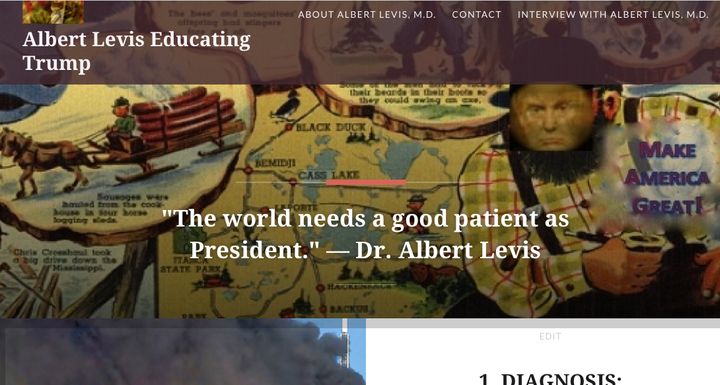
Levis’ Trump blog is a nine series wellness diagnosis and prescription for Donald Trump, whom he refers to as Bannon/Bunyan with his pit bull Babe in the Oval Office.
LS: You have commenced publishing an ongoing web series “The Education of Trump” that explains the core of your wellness diagnosis and Formal System in the singular figure of Donald Trump. You begin with the fact that diagnosticians are prevented from providing a diagnosis of a patient without their participation in an examination and their consent. And then you launch into your diagnosis of Trump. Explain how you granted yourself permission to do this.
AL: I am addressing the issue of diagnostic alternatives as wellness conditions. In offering the example of Trump’s wellness, I introduce an insightful study of personal dynamics of conflict resolution that educate the person under study (Trump) and the audience (the American public). The diagnosis is a wellness category without in any way stigmatising the recipient. Everybody can make his diagnosis asking the simple three questions: is he dominant or submissive, is he cooperative or antagonistic, is he respectful or disrespectful? And then identifying his pattern as six interconnected emotions.
LS: How do you represent the much-maligned Trump without stigmatising him?
AL: I see his emergence as the defender of America in the context of Jihadist Islam as an invasive religion. Religions are analysed as also having relational modality dimensions. The purpose of “The Education of Trump” is to enlighten the public regarding a new psychological wellness model but also as learning about power management and relational pathology. But there is another crucial motivation for its dissemination: to introduce this model of diagnosis to world religions. I am addressing the key issue unaddressed by society: religions are not metaphysical but psychological in origin and they need to understand morality as a science and their value systems as partial understandings of science.
LS: This is a crucial and even revolutionary statement, as every religion has a story of divine origins. Could this be the significance of the Trump card at this crucial impasse?
AL: Trump’s evolution is an equilibrial response to Islamic terrorism. We need to recognise the normative determinations of religions in their powerful influence of generating conflicts instead of resolving them.
LS: I was stunned by the multiple metaphors you were using for Trump’s diagnosis. These include: a cowardly lion, a Minotaur, a Sumo wrestler and Paul Banion, an American hero. And yet, you acknowledge Trump as a leader. Are you suggesting that to be so bold in projecting an image of strength makes someone automatically a leader?
AL: Paul Bannon/Bunyan with his pit bull Babe in the Oval Office shows Trump as an American Hero. He is for many people. The metaphor of the cowardly lion is useful in presenting the dynamics of aggressiveness and paranoia. Pit bull is a good metaphor for his cynical behaviour. I also call him King Trump, protector of NY’s skyline, in a deadly feud — King Kong, Jihadist terrorists wrecking havoc on the skyline.
LS: King Kong is the death-defying Islamic practice of suicide bombers?
AL: Terrorism reflects dominant antagonism.
LS: Projecting an image of strength alone is not what Americans have been taught about leadership, yet it seems fitting for an age of duelling surface images masking deeper truths. How does the Formal System penetrate surface projections to enter into deeper processes that generate conflict between nations?
AL: Science will prevail as it has multiple meaningful applications both for politics and for psychology and education. The world will learn to speak a new language that has the grammar of passivity and activity forms and the syntax of the six-role process as the parameters for the scientific interpretation of metaphors and the diagnoses of individuals and cultures.
LS: Do these multiple images of aggression mean that Trump is the perfect Shadow for America’s negative projections at the time of the decline of its empire?
AL: Trump rose to power to deal with Islam. Both are dominant antagonistic in their identities and values. His election is as equilibrial in dealing with Islam. As our collaboration here just highlighted, King Trump rose as a leader to fight Islam as King Kong. Yet there is a deeper paradox at work: Trump is rapidly becoming a caliph causing the Islamization of America. America is now experiencing here a caliph in charge, with the power and defences of a caliph in the technological age on display – the control of the press, restraint of liberties, suppression of women’s rights and protection of the rich. America is a free thinking realm that knows that process resolves conflicts. Educating Trump might help us all to learn about power management.
LS: This view of Trump as the unconscious means of establishing a conscious equilibrium to the death defying tactics of Islam helps me to see how the negative metaphors add up to America’s Shadow. If your wellness diagnosis views Trump as the symptom of America’s dis-ease, it logically follows that healing Trump means healing America. How do you view a practical passage from sickness to a wellness diagnosis will take place?
AL: Trump would benefit greatly from learning about the consequences of aggressive behaviour. He could learn because he suffers many fears, much anxiety. He would welcome somebody telling him: “You are not narcissistic or crazy but simply you are overpowering, antagonistic and disrespectful”. From the start, his diagnosis would transform “incurable narcissist” to curable wellness personality diagnosis benefiting from connecting being too powerful and being scared. The origin of his fears, his paranoia and his defensiveness are caused by his own aggressiveness. He might consider then managing his power to decrease his anxieties.
LS: In this case, America has the opportunity for healing along with their caliph.
AL: He has lost balance in his life and is being ridiculed for his lapses of judgment sourced in his disequilibrium. The president needs this model even more than others because his arrogance won’t allow him to be vulnerable to a conventional therapist. My vision extends from Trump getting relief through this education to becoming a good role model of resolution. He could then be an icon of conflict resolution and personal growth for his global audience. Though I have given him a wellness diagnosis, he is a patient; patients can become cured and help with the healing of others. The world needs a good patient as President.
LS: Do you have particular suggestions that you would carry into a Oval Office meeting with Trump?
AL: Yes, in fact I do. Here they are in sequence: explore the scientific validation of the theory with a multicenter research initiatives; identify the religious leaders of the Abrahamic religions to consider how their moral paradigms are destroying the potential for world unity and give them the assignment of reconciling their role management alternative positions with Moral Science principles of conflict resolution as the ultimate moral values; and assemble educators to collaboratively achieve the three elusive objectives of education: integration of the humanities and the sciences, development of self-knowledge and the adoption of the Moral Science clarifying universal values and integrating religions as partial and complementary discoveries of the science.
LS: How might you concretely begin this “Education of Donald Trump” with a greeting to the president in his seat of power?
AL: I would start by reassuring him that he can feel safe again free from all his fears simply by scaling down his acting like a bully. Then, I would give him an incentive to make changes. I would tell him “Donald do you want to transform the world into a peaceable kingdom? All you have to do is simply be a role model of introspection and humility and stop being a role model of righteousness”. I would also suggest that he enter into a peer group with other bullies of the world, so admired for their big egos. He could iInvite them for monthly session to a nice resort in Switzerland, where they all have their bank accounts or to play gold in one of his resorts.
LS: And then you can have them play a global game of Moral Monopoly so these tremendous egos responsible for the future course of the planet can understand their roles as agents in the evolution of global conflict resolution. Thank you very much Albert Levis for this illuminating, paradigm shifting interview.
AL: Thank you. Incidentally, can you share the series of blogs on the education of the president with him?
LS: I am not a personal friend of Donald Trump, but I will do my best. He isn’t much of a reader, as you know.
Dr. Albert Levis’ “Educating Trump” blog with his nine step diagnosis and prescription for Trump: educating trump albert levis md
The Conflict Analysis Battery can be downloaded at: conflictanalysisbattery.com/
Albert Levis, M.D., the inventor of Moral Science, puts his approach into practice at his Museum of Creative Process in Vermont where he connects Formal Theory to the artistic process through exhibitions and workshops. A practicing psychiatrist for over forty years, Levis was trained at the Universities of Zurich and Geneva, the University of Chicago and Yale. The author of numerous texts — including The Formal Theory of Behavior, Conflict Analysis Training and Science Stealing the Fire of the Gods — Dr. Levis founded and directed the Center for the Study of Normative Behaviour in Hamden, Connecticut before founding the Museum of Creativity along with the family run Wilburton inn in Manchester, Vermont. His Creative Assessment Battery is available online through conflictanalysis.com the museum website: http://www.museumofthecreativeprocess.com
Lisa Paul Streitfeld, Ph.D., is a Kultureindustrie theorist and art critic examining art from a quantum science perspective.
All photos of Albert Levis and his family are courtesy of photographer Jim Gipe.
